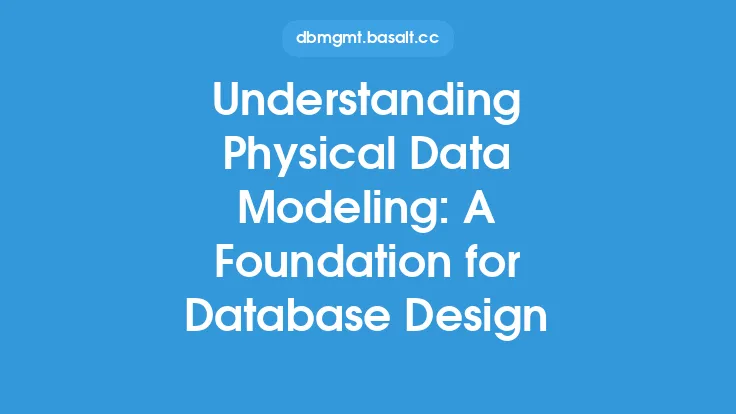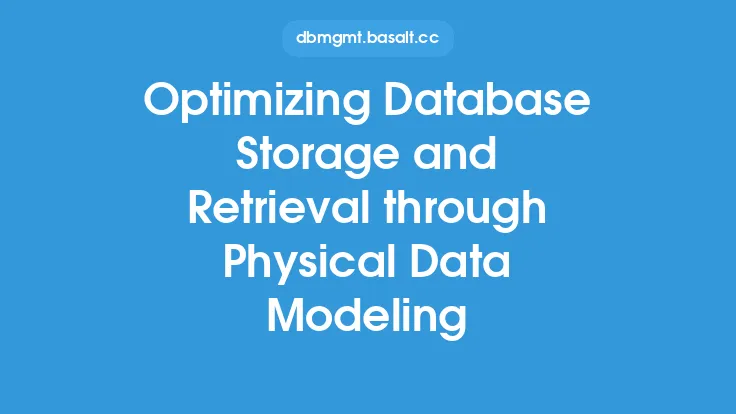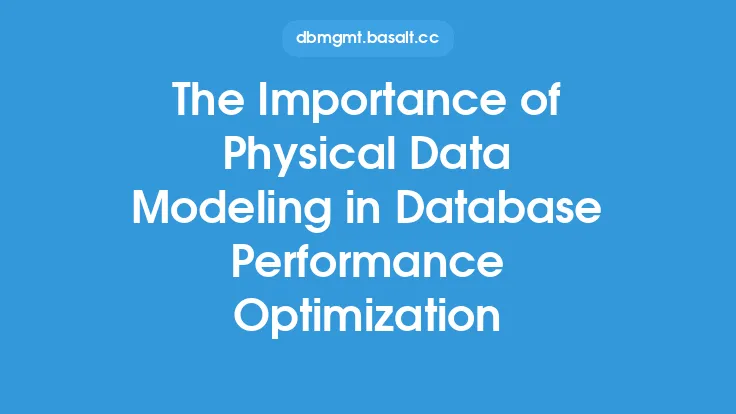Physical data modeling is a crucial step in the database design process, serving as the bridge between logical design and database implementation. It involves transforming the logical data model into a physical model that can be used to create a database. This process requires a deep understanding of the database management system (DBMS) being used, as well as the specific requirements of the application or system being developed.
Introduction to Physical Data Modeling
Physical data modeling is a critical component of the data modeling process, as it provides a detailed representation of the database structure and organization. It takes into account the physical storage and retrieval of data, as well as the relationships between different data entities. The physical data model is used to guide the implementation of the database, ensuring that it is optimized for performance, scalability, and data integrity.
Key Components of Physical Data Modeling
There are several key components of physical data modeling, including:
- Table design: This involves defining the structure of each table in the database, including the columns, data types, and relationships between tables.
- Indexing: This involves creating indexes on columns to improve query performance and reduce the time it takes to retrieve data.
- Partitioning: This involves dividing large tables into smaller, more manageable pieces to improve performance and reduce storage requirements.
- Data types: This involves selecting the appropriate data types for each column, taking into account factors such as storage requirements, data precision, and query performance.
- Constraints: This involves defining rules and constraints to ensure data consistency and accuracy, such as primary keys, foreign keys, and check constraints.
Physical Data Modeling Techniques
There are several physical data modeling techniques that can be used to optimize database performance and scalability. These include:
- Denormalization: This involves intentionally deviating from the principles of normalization to improve query performance and reduce the number of joins required.
- Data warehousing: This involves creating a separate database or schema to store data for reporting and analysis purposes, often using a star or snowflake schema.
- Data compression: This involves reducing the storage requirements for data by using compression algorithms or techniques such as run-length encoding.
- Data encryption: This involves protecting data from unauthorized access by using encryption algorithms or techniques such as SSL/TLS.
Tools and Technologies for Physical Data Modeling
There are several tools and technologies available to support physical data modeling, including:
- Database management systems: Such as Oracle, Microsoft SQL Server, and IBM DB2, which provide a range of features and tools to support physical data modeling.
- Data modeling tools: Such as ER/Studio, PowerDesigner, and Enterprise Architect, which provide a graphical interface for creating and editing physical data models.
- SQL editors: Such as SQL Server Management Studio, Oracle SQL Developer, and DB2 Data Studio, which provide a range of features and tools to support physical data modeling and database implementation.
Best Practices for Physical Data Modeling
There are several best practices that can be followed to ensure effective physical data modeling, including:
- Follow a structured approach: This involves following a structured approach to physical data modeling, including defining requirements, creating a logical data model, and transforming it into a physical data model.
- Use standardized naming conventions: This involves using standardized naming conventions for tables, columns, and other database objects to improve clarity and consistency.
- Optimize for performance: This involves optimizing the physical data model for performance, taking into account factors such as query patterns, data distribution, and storage requirements.
- Test and validate: This involves testing and validating the physical data model to ensure that it meets the requirements and is free from errors.
Common Challenges and Pitfalls
There are several common challenges and pitfalls that can be encountered during physical data modeling, including:
- Insufficient understanding of the DBMS: This can lead to a physical data model that is not optimized for the specific DBMS being used.
- Inadequate testing and validation: This can lead to a physical data model that contains errors or does not meet the requirements.
- Over-normalization: This can lead to a physical data model that is overly complex and difficult to maintain.
- Under-normalization: This can lead to a physical data model that is prone to data inconsistencies and errors.
Conclusion
Physical data modeling is a critical step in the database design process, providing a detailed representation of the database structure and organization. By following a structured approach, using standardized naming conventions, optimizing for performance, and testing and validating the physical data model, developers can create a database that is optimized for performance, scalability, and data integrity. By understanding the key components, techniques, and best practices of physical data modeling, developers can create a database that meets the requirements of the application or system being developed, and provides a solid foundation for future growth and development.





